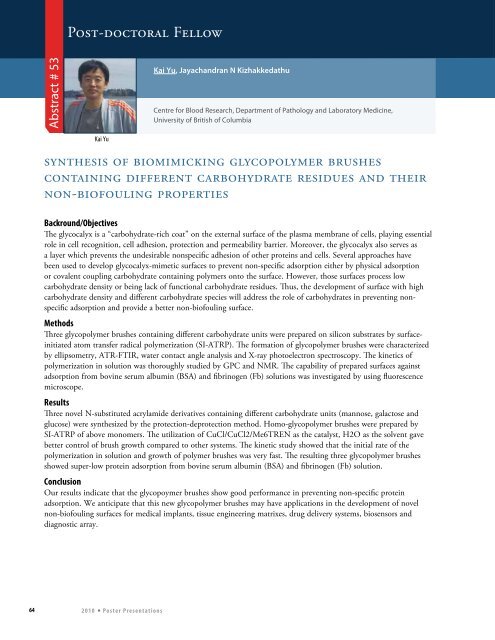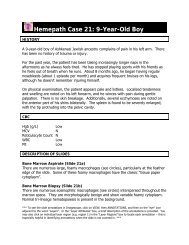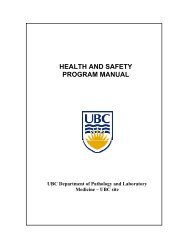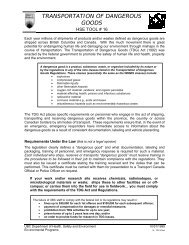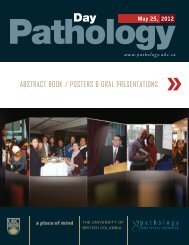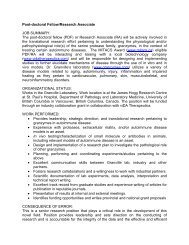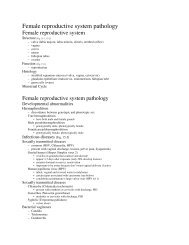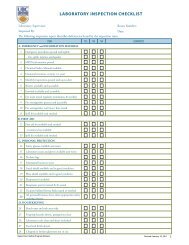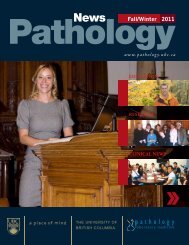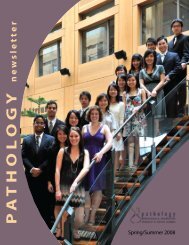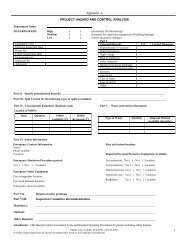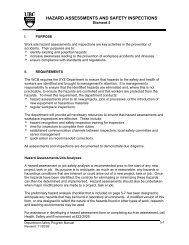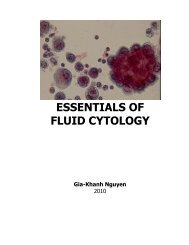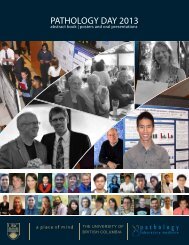Post-doctoral FellowAbstract # 53Kai Yu, Jayach<strong>and</strong>ran N KizhakkedathuCentre for Blood Research, Department of <strong>Pathology</strong> <strong>and</strong> <strong>Laboratory</strong> <strong>Medicine</strong>,<strong>University</strong> of British of ColumbiaKai Yusynthesis of biomimicking glycopolymer brushescontaining different carbohydrate residues <strong>and</strong> theirnon-biofouling propertiesBackround/ObjectivesThe glycocalyx is a “carbohydrate-rich coat” on the external surface of the plasma membrane of cells, playing essentialrole in cell recognition, cell adhesion, protection <strong>and</strong> permeability barrier. Moreover, the glycocalyx also serves asa layer which prevents the undesirable nonspecific adhesion of other proteins <strong>and</strong> cells. Several approaches havebeen used to develop glycocalyx-mimetic surfaces to prevent non-specific adsorption either by physical adsorptionor covalent coupling carbohydrate containing polymers onto the surface. However, those surfaces process lowcarbohydrate density or being lack of functional carbohydrate residues. Thus, the development of surface with highcarbohydrate density <strong>and</strong> different carbohydrate species will address the role of carbohydrates in preventing nonspecificadsorption <strong>and</strong> provide a better non-biofouling surface.MethodsThree glycopolymer brushes containing different carbohydrate units were prepared on silicon substrates by surfaceinitiatedatom transfer radical polymerization (SI-ATRP). The formation of glycopolymer brushes were characterizedby ellipsometry, ATR-FTIR, water contact angle analysis <strong>and</strong> X-ray photoelectron spectroscopy. The kinetics ofpolymerization in solution was thoroughly studied by GPC <strong>and</strong> NMR. The capability of prepared surfaces againstadsorption from bovine serum albumin (BSA) <strong>and</strong> fibrinogen (Fb) solutions was investigated by using fluorescencemicroscope.ResultsThree novel N-substituted acrylamide derivatives containing different carbohydrate units (mannose, galactose <strong>and</strong>glucose) were synthesized by the protection-deprotection method. Homo-glycopolymer brushes were prepared bySI-ATRP of above monomers. The utilization of CuCl/CuCl2/Me6TREN as the catalyst, H2O as the solvent gavebetter control of brush growth compared to other systems. The kinetic study showed that the initial rate of thepolymerization in solution <strong>and</strong> growth of polymer brushes was very fast. The resulting three glycopolymer brushesshowed super-low protein adsorption from bovine serum albumin (BSA) <strong>and</strong> fibrinogen (Fb) solution.ConclusionOur results indicate that the glycopoymer brushes show good performance in preventing non-specific proteinadsorption. We anticipate that this new glycopolymer brushes may have applications in the development of novelnon-biofouling surfaces for medical implants, tissue engineering matrixes, drug delivery systems, biosensors <strong>and</strong>diagnostic array.64 2 0 1 0 * P o s t e r P r e s e n t a t i o n s
Graduate StudentIan M. Wilson 1 , Katey S. S. Enfield 1 , Emily A. Vucic 1 , Raj Chari 1 , Yu-An Zhang 2 ,Ming You 3 , Calum MacAulay 1 , Stephen Lam 1 , Adi F. Gazdar 2 , Wan L. Lam 11Bristish Columbia Cancer Research Centre, 2 <strong>University</strong> of Texas Southwestern MedicalCentre, Dallas, TX. 3 <strong>University</strong> of Toronto, Toronto, ONAbstract # 54Catherine Enfielda novel lung tumor suppressor implicated in somatic<strong>and</strong> familial cancersBackround/ObjectivesLung cancer (LC) is the most common cause of cancer death worldwide. Previous familial linkage studies haveidentified a tumor suppressor locus on 6q23-25. However, no single gene has yet been implicated within this 30 Mbregion. Discovering the genetic <strong>and</strong> epigenetic events that affect LC risk <strong>and</strong> development will lead to better methodsfor risk assessment, early detection <strong>and</strong> treatment.MethodsGenome-wide genes disrupted by two-hit inactivation were identified by combining gene dosage, DNA methylation,<strong>and</strong> gene expression assays for a group of lung adenocarcinomas (AC) <strong>and</strong> adjacent non-malignant tissues. Geneexpression, DNA hypermethylation <strong>and</strong>/or copy number aberrations were validated in data from AC, squamouscell carcinoma (SqCC), <strong>and</strong> pre-malignant lesions by querying other cohorts using gene-specific <strong>and</strong> wholegenomeapproaches. The role of DNA methylation in gene silencing was assessed using inhibition of DNMT by5’-azacytidine. The association of allelic variants with LC risk was investigated in 193 familial LC cases <strong>and</strong> 213controls collected by the Genetic Epidemiology of Lung Cancer Consortium (GELCC) using a Cochrane-Armitagetrend test. The association of gene expression with prognosis was performed on public data using a Mantel-Cox logtest. Stable mRNA knock-downs were generated using lentiviral delivery of a gene-specific shRNA, <strong>and</strong> apoptoticcells were counted using Annexin5/propidium iodide staining.ResultsIntegration of AC gene dosage, DNA methylation <strong>and</strong> mRNA expression showed EYA4 to be frequently affected bytwo-hits <strong>and</strong> significantly down-regulated. Quantitative PCR techniques confirmed that EYA4 was hypermethylated(46%) <strong>and</strong> down-regulated (72%), validating our microarray results. A direct link between EYA4 methylation <strong>and</strong>expression was verified by restoration of expression after 5’-azacytidine treatment in methylated cell lines. Congruentwith EYA family member function, in vitro assays revealed that EYA4 knock-down cells displayed a decrease inthe number of apoptotic cells - a hallmark of cancer. Further investigations led to the discovery of frequent EYA4disruption in SqCC <strong>and</strong> pre-neoplastic tissue. The GELCC dataset was examined to assess EYA4 allelotype associationwith familial risk. Doing so revealed that numerous EYA4 variants are associated with increased risk. Finally, theassociation of EYA4 expression with survival was investigated along with other somatically altered genes at 6q23-25.Of these genes, low EYA4 expression was found to be the most significantly associated with poor prognosis.ConclusionEYA4 is a frequently disrupted gene that maps to a locus previously associated with cancer risk. It is implicatedin somatic as well as familial cancers, <strong>and</strong> is likely a tumor suppressor gene with apoptotic functions. The directassociation of EYA4 with risk <strong>and</strong> survival underscores its relevance on a clinical level.Poster <strong>Presentations</strong> * 2 0 1 065
- Page 2:
PathDay: Keynote Speaker (4:30 pm)T
- Page 5:
Conference Outline2010abstract #14
- Page 9 and 10:
Table of Contentabstract #57 The ro
- Page 11 and 12:
ResidentClinical SciencesArwa Al-Ri
- Page 13 and 14: ResidentTitus Wong 1 , Marc Romney,
- Page 17 and 18: ResidentD. Turbin 1 , D. Gao 2 , J.
- Page 19 and 20: ResidentDavid F Schaeffer 1 , Eric
- Page 21 and 22: ResidentMajid Zolein 1 , Daniel T.
- Page 23 and 24: Graduate StudentAshish K. Marwaha 1
- Page 25 and 26: Graduate StudentAmanda Vanden Hoek
- Page 27 and 28: Graduate StudentXin Ye 1 , Mary Zha
- Page 29: Graduate StudentLisa S. Ang 1 , Sar
- Page 32 and 33: Graduate StudentAbstract # 22Brian
- Page 36 and 37: OtherAbstract # 25Crystal Leung, Li
- Page 38 and 39: OtherAbstract # 27Lise Matzke 1 , W
- Page 40 and 41: Graduate StudentAbstract # 29Varun
- Page 42 and 43: Graduate StudentAbstract # 31Maite
- Page 44 and 45: Post-doctoral FellowAbstract # 33Ra
- Page 46 and 47: Graduate StudentAbstract # 35Hayley
- Page 48: Post-doctoral FellowAbstract # 37Es
- Page 51 and 52: ResidentAhmad Al-Sarraf MD 1, 2 , G
- Page 53 and 54: OtherRebecca Towle 1 , Danielle Mac
- Page 55 and 56: Graduate StudentPaul R. Hiebert 1,2
- Page 57 and 58: Graduate StudentV. Montoya 1 , J. G
- Page 59 and 60: OtherWalter Martz and Henry Kalicia
- Page 61 and 62: OtherKatelyn J. Janzen 1 , Elizabet
- Page 63: Graduate StudentJasmine L. Hamilton
- Page 67 and 68: Graduate StudentKelsie L. Thu 1,3 ,
- Page 69 and 70: OtherLiat Apel-Sarid 1 , Doug Cochr
- Page 71 and 72: Graduate StudentJennifer R. Choo 1,
- Page 73 and 74: Graduate StudentEdwin S. Gershom 1
- Page 75 and 76: OtherYing Qiao 1, 2 , Chansonette H
- Page 77 and 78: Graduate StudentLeslie YM Chin 1,4
- Page 79 and 80: Graduate StudentBillie Velapatiño
- Page 81 and 82: Graduate StudentSophie Stukas 1 , S
- Page 83 and 84: Graduate StudentKyluik DL and Scott
- Page 85 and 86: Post-doctoral FellowJoel Montane 1
- Page 87 and 88: IndexAAbozina A. 45Abraham T. 55All
- Page 89: Ye X. 27, 82Yee S. 31Yoshida E. 12Y


